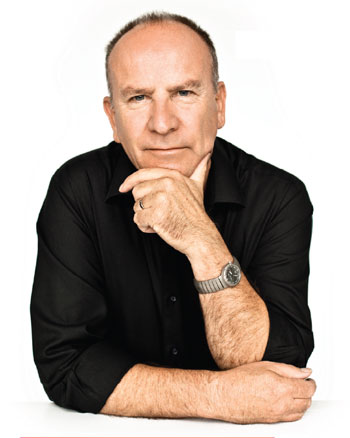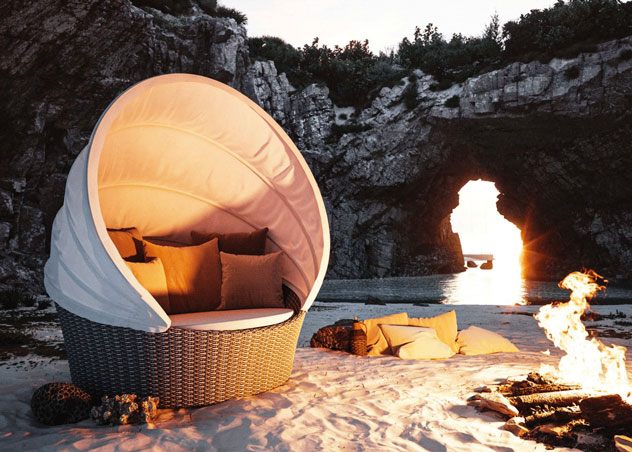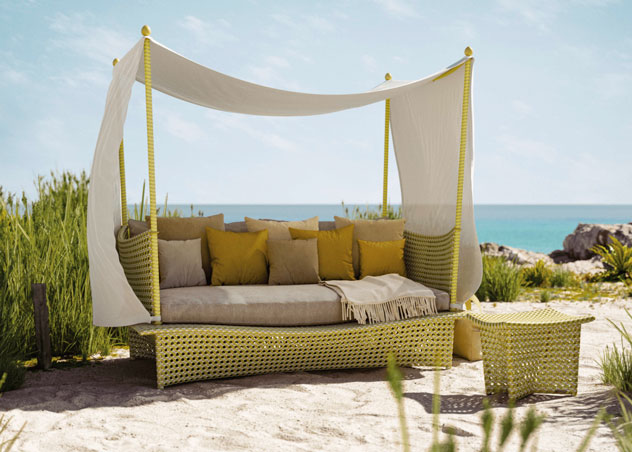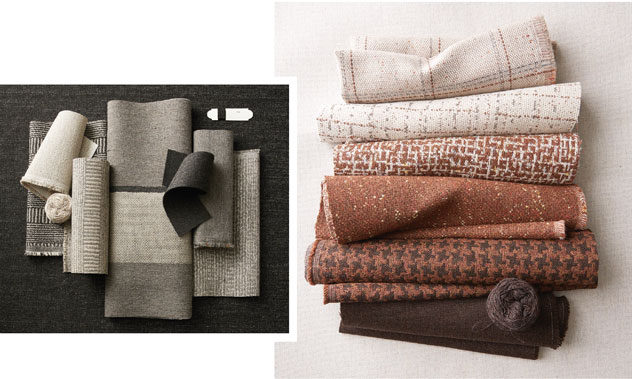Interview With Designer Richard Frinier
Designer Richard Frinier answers questions about the present and future of
outdoor furnishings trends and design.
Furniture World spoke with Richard Frinier, the iconic outdoor furniture and
fabric designer whose work encompasses hundreds of collections and thousands
of individual product designs across furniture, textiles, lighting and
accessories. These range from soft modern and contemporary to transitional,
traditional and exotic forms with an unmistakable essence of understated
modernity blended with neoclassicism.
Due to his extraordinary passion for and dedication to his work, Frinier has
garnered over 90 design excellence and career achievement awards. He is
regarded as one of the premier designers of indoor/outdoor furniture and
textiles for his design innovation and longstanding commitment to the design
trade and home furnishings industries.
Major Trends
Question: What are some of the major trends you see in the
market with regard to outdoor furniture styles, colors and utility?
Answer: It is a very interesting time for research, design,
and development to create products that meet the moment and create what
comes next.
During the pandemic, people around the world were required to re-prioritize,
reorganize and in many cases reinvent much of their lives. Originally, this
was out of necessity, but more and more by choice and by design.
We used to talk about blurring the lines between indoor and outdoor living.
Now we are blurring the lines as to how, when and where we are working and
learning. This has resulted in making all of us more open and imaginative as
to how we create and adapt our previously personal spaces. This is strongly
influencing and fueling popular live-work-play social trends that our
industry is or should be greatly benefiting from at this time and going
forward.
Prior to the pandemic, major contract and hospitality furniture
manufacturers and marketers capitalized on the reverse concept—making the
office feel like home. It is no surprise that our interest, desire and need
to transform areas of our personal spaces have found our industry blurring
and crossing if not erasing these real or imaginary lines. For those who
embrace this concept and trend, there is potential to increase market shares
overall.

Designer Richard Frinier
“We used to talk about blurring the lines between indoor and outdoor living.
Now we are blurring the lines as to how, when and where we are working and
learning.”
Trending Indoor & Outdoor
Question: What advances in outdoor furniture materials are
or could have the potential to advance the category?
Answer: Technical fabrics will be a big part of creating
different options for seating design and construction. Recycled-content
textiles will continue to evolve and grow in scope, availability and
popularity. From a design perspective, I embrace this evolution, as it
builds upon and capitalizes on the remarkable performance fabrics we all use
and enjoy today.
Comfort is always key for everyone, so I like to recommend that retailers
and buyers always sit-test a range of furniture styles with an array of
seating options from sling to strap to cushions (thin and thick) to woven
materials and wood, etc., to fully understand and appreciate the available
options and differences. People often surprise themselves with their final
choices when they take time to sit-test the furniture, just as they would
test-drive an automobile.
The furniture industry is a fashion industry, so color trending is an
important part of product development and not just part of the storytelling
and marketing of new designs. Furniture and textile products in the outdoor
category are driven by the materials we use, including performance,
viability, availability, and the ways in which we are able to transform them
with various finishing techniques. People have often heard me say, “If it is
trending—it is ending.” Meaning, a color trend may only last one or two more
seasons by the time it is recognized as a trend. It is then seen everywhere,
often followed by nowhere. Before consumers love or hate a design or its
color, it is up to manufacturers, retailers, distributors, interior and
exterior space designers to research, develop, sell, distribute and specify
a diverse offering of products and textiles they have curated for their
following—indoors or outside.
Designing Outdoor Spaces
Question: Is there a significant difference between how
consumers should approach furnishing their outdoor and indoor spaces?
Answer: Mixing and matching furniture styles is very common
and popular today. It creates a visual relief from looking at too many
pieces that are all the same and it can make outdoor areas and rooms much
more flexible, functional and efficient.
In my opinion, people should spend time in the outdoor spaces they plan to
create after removing or moving aside any furnishings that are already
there. That helps them more easily imagine and visualize how they want to
use these open areas, what they want to replace, add or simply reconfigure
and refresh with new fabrics. The smallest of spaces can be transformed into
a personal retreat — even if it is just one chair and a small table on a
balcony. More open and generous spaces provide a blank slate or stage upon
which to build the outdoor experience each person dreams about for
themselves, their family and friends. People don’t need to do it all at
once. Adding to a space over time is a mindful and successful approach that
also provides retailers with an opportunity to follow up and assist
customers.
Retail Displays
Question: How might outdoor furniture manufacturers and
retailers better merchandise and display outdoor furnishings?
Answer: I cannot emphasize enough the importance of visual
merchandising and display as well as photography. Because we only have so
much space here to share ideas, I will emphasize that if a manufacturer or
retailer does not have talent inside their company to realize their brand
visually, they need to research, identify and hire the very best people who
can bring this to them and their following.
The use of CGI photography is spreading rapidly, and some do it better than
others. It is not just about layering furnishings with an ocean or mountain
view in the background. It is about creating visuals that draw people in and
evoke emotion and experience. I am starting to see this with a few
higher-end, brands. Again, if you do not have in-house talent, you must
bring in new talent to do it right.
For retailers, I highly recommend that they make sure the products they
purchase for stores and showrooms are made by brands with the best
marketing, visual display and merchandising assets. An old adage comes to
mind, “A picture is worth a thousand words.”
“People have often heard me say, ‘If it is trending—it is ending.’ It is
then seen everywhere often followed by nowhere.”
What’s Missing Today?
Question: In a 2016 Furniture World interview you told us,
“Over the course of my career, I have approached design as an art historian,
always looking for what came before and what is missing, including
indigenous cultures that had not yet been influenced by international
style.” What do you see that came before and is missing right now that is
likely to affect what consumers will find at retail in the coming years?
Answer: I have been practicing my craft for over 40 years.
In that time, I have seen a lot of design cycles, market launches and trends
come and go. Yet, there are still voids in the marketplace. I am always in
search of what is missing, and on a journey to imagine and realize what can
be.
I am humbled to have created designs that have resonated with others and
either remained in production or been around for many years. Two of these
designs, Daydream and Orbit, created for DEDON, each celebrate an
approximately 20-year anniversary. They’ve been re-imagined with intriguing
new weave patterns and contemporized colorways launched at the 2023 Milan
Furniture Fair.
When you ask what has come before that may be missing right now, I think
these designs may be the best answer coming from me because in many ways
they represent escapism. People tell me that these designs instantly draw
them in, emotionally transporting their minds and spirits by either giving
them a space in which to relax alone or visit with a friend or two under the
sun or stars. During the pandemic, people wrote to me to thank me and send
me pictures of themselves and or their children working or studying in their
Orbit or Daydream lay around daybeds—making their time in quarantine less of
a problem and more of a great experience.

Pictured Above: ORBIT I Richard Frinier for DEDON. Image courtesy of
DEDON.
Eclectic & Curated
Question: Another quote from our 2016 interview was,
“Today, more interior designers are looking at outdoor furniture and asking,
‘How do I make my client’s outdoor areas, balcony, rooftop, or screened-in
room look more eclectic and more curated like the rest of the house? How do
we mix this up and still make it look attractive?’ Do you see retailers and
consumers more willing to give this idea consideration?
Answer: It really depends on the retailer and their
following. If a retailer’s customer base desires or requires these features
to enhance and complete their live-work-play home environment, then the
industry, retailers and distributors need to be ready to meet the moment.
If a customer wants to be able to watch movies or sporting events with
family and friends outside, that feature can become an important focal point
for an outdoor room with outdoor screens.
For my own spaces, I am a less-is-more individual. One home and studio is
modern, minimalist and open to nature. It is located in a rural area with a
fully integrated home automation system that includes lighting and music
elements that are infinitely additive and do not compete with nature. In our
other home, a classic California Mediterranean style in a coastal city, our
outdoor space has virtually no automation by design in keeping with the
original mood that is laid back, simple and romantic. It represents a less
chaotic time and lifestyle. The simplicity of the place encourages
gatherings that are more conversational and less sensational.
“Adding to a space over time is a mindful and successful approach that also
provides retailers with an opportunity to follow-up with customers to help
them add or replace items.”
Design Inspiration
Question: What sources of information such as shows, trend
forecasters, magazines, intuition, etc., do you use to inform your sense of
what you should be doing next in terms of design?
Answer: I have always had an eye for design and a desire to
travel, so I maintain a keen awareness of the global marketplace. While I do
appreciate the work of others making new and interesting designs, this is
not where my ideas come from out of respect for them and for myself.
Ideas have always come easily to me — often outside the studio during or
after a long walk, a drive along the coastline or drifting and dreaming in
the pool. I like to have a cappuccino and enjoy a half hour to sit in the
garden in the afternoon sunlight where I then find myself working through
design engineering challenges in my mind. It is often the limitations that
lead to innovative breakthroughs.
All of the designs I create are imagined and intended for the individual
brands I work with. And while it is my job to bring designs to them, it is
very much a collaborative effort. For me, design is neither a commodity nor
interchangeable across clients.
I believe that good design is able to make an emotional connection with
others when it is perceived to have a soul. It draws us in and speaks to us.
It moves us because it is evocative if not provocative. The best designs are
unique and innovative — worthy of someone buying and making them a part of
their home.

Pictured Above: DAYDREAM I Richard Frinier for DEDON. Image courtesy
of DEDON
The Next Generation
Question: You are well known for your support of programs
that invest in the future of students who will design the next generation of
outdoor furniture. Can you comment on your passion for doing this?
Answer: I am compelled to introduce young designers to our
furniture and textile industries and more specifically to the outdoor sector
as a viable and rewarding path to consider and explore. In my opinion, the
outdoor category remains one of the most dynamic and growing industries.
While I have served as judge or juror for various professional and student
design contests, I support design students directly by rewarding their
talents through scholarship funds to go toward their education in a
meaningful way. The monetary prize for the winning student in our 2023 ICFA
/ Richard Frinier Design Competition has been raised to $5,000 for the
winning student to further inspire their participation and support from
schools and professors. The winner is afforded the opportunity to enhance
and advance their creative skills by imagining, visualizing and presenting a
winning design to perhaps illuminate the future of outdoor living. In
addition to design education funds, they receive an all-expense-paid trip to
Atlanta to attend the Casual Market at AmericasMart, get an introduction to
industry leaders, mentoring time, attend the 2023 ICFA Annual Meeting for
their award presentation, and experience media exposure for their
participation and winning design. (See
https://www.icfanet.org/richardfrinierdesignscholarship
for more information.)
I am always happy to see the designs the students bring, what inspired them,
how they present and articulate their designs, and how they create a story
around their concept.
New Casual Show Venue
Question: Do you have any comments about the new
AmericasMart venue for the Casual Show in July?
Answer: As someone who attended all but a handful of the
casual markets when it was held at the Merchandise Mart in a town where my
mother was born and a place I always enjoyed visiting, I am grateful for the
history of the show, the many people who have been a part of it for all of
these years and for how much a part of my own career the show has been.
While I will miss having it there, I also look forward to the change in
venue. Especially post-pandemic, I believe that this is a great time to
create new experiences, successes and memories starting in July of this
year.
Current Projects
Question: What kinds of interesting projects on the fabric
and furniture design side have you been working on since we last spoke?
Answer: Recent textile collections I have launched with
Glen Raven/Sunbrella include RETWEED and REFLECTIONS.
My inspiration for RETWEED was to blend the textural surface design and
styling of vintage tweeds with an updated mid-century modern aesthetic using
Sunbrella’s unique recycled-yarn content in compelling ways to bring these
designs to life. It has been rewarding to see this collection generate so
much interest in the marketplace and to be praised by high-level design
trade organizations for the work that went into them. Gratefully, we have
received multiple awards including the ICFA’s Design Excellence Award for
Best of Category, the Industrial Designers Society of America’s IDEA Award,
Interior Design magazine’s Best of Year honoree, and the Chicago Athenaeum
Museum’s coveted Green Good Design and Good Design awards respectively along
with inclusion into the museum’s permanent archival collection.
Our newest textile collaboration launching now is REFLECTIONS, inspired by
my deep appreciation for the artistry of weaving. These textural
constructions and patterns celebrate the spirit of craftspeople around the
world. REFLECTIONS also incorporates Sunbrella’s recycled-yarn content
intentionally infusing random irregularities which add incredible depth,
richness and originality to the constructions, textures, patterns and
colors. These unique characteristics become a subtle symbol of the inherent
beauty found in perfectly imperfect things we see in nature, hand-woven
objects and across the spectrum of recycled-content goods so important and
popular today.
On the furniture side, I am designing new indoor/outdoor designs for several
of my clients, which I will look forward to sharing with you in the future.

Left: REFLECTIONS, Right: RETWEED
Richard Frinier for Sunbrella Image courtesy of Sunbrella